
La Palma, also known as La isla bonita and historically San Miguel de La Palma, is the most northwesterly island of the Canary Islands, Spain. La Palma has an area of 708 square kilometres (273 sq mi) making it the fifth largest of the eight main Canary Islands. The total population at the end of 2020 was 85,840, of which 15,716 lived in the capital, Santa Cruz de La Palma and about 20,467 in Los Llanos de Aridane. Its highest mountain is the Roque de los Muchachos, at 2,426 metres (7,959 ft), being second among the peaks of the Canaries after the Teide massif on Tenerife.
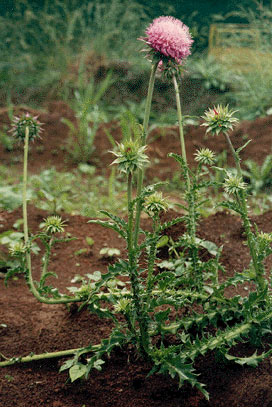
Carduus nutans, with the common names musk thistle, nodding thistle, and nodding plumeless thistle, is a biennial plant in the daisy and sunflower family Asteraceae. It is native to regions of Eurasia.

Teide, or Mount Teide, is a volcano on Tenerife in the Canary Islands, Spain. Its summit is the highest point in Spain and the highest point above sea level in the islands of the Atlantic. If measured from the ocean floor, its height of 7,500 m (24,600 ft) makes Teide the third-highest volcano in the world, and is described by UNESCO and NASA as Earth's third-tallest volcanic structure. Teide's elevation above sea level makes Tenerife the tenth highest island in the world.
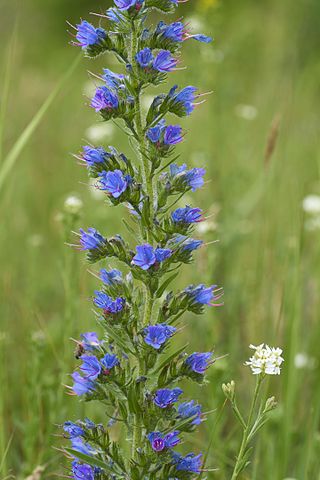
Echium vulgare, known as viper's bugloss and blueweed, is a species of flowering plant in the borage family Boraginaceae. It is native to most of Europe and western and central Asia and it occurs as an introduced species in north-eastern North America, south-western South America and the South and North Island of New Zealand. The plant root was used in ancient times as a treatment for snake or viper bites. If eaten, the plant is toxic to horses and cattle through the accumulation of pyrrolizidine alkaloids in the liver.
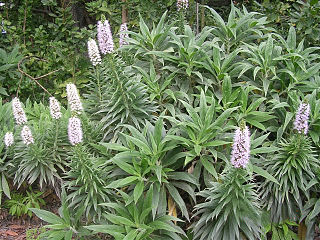
Echium virescens is a flowering plant in the genus Echium. It is endemic to the island of Tenerife, mainly in Macizo de Anaga and the Orotava Valley. It grows in forests and on lower south slopes of the island.
Tower of jewels may refer to:

Echium wildpretii is a species of flowering plant in the family Boraginaceae. It is an herbaceous biennial plant that grows up to 3 m (10 ft) in height. The species is endemic to the Canary Islands, and is found mainly in the national park surrounding Mount Teide in Tenerife. The subspecies E. wildpretii subsp. trichosiphon occurs at high altitudes on the island of La Palma. The common names are tower of jewels, red bugloss, Tenerife bugloss or Mount Teide bugloss.

Echium sabulicola is a plant in the genus Echium. It is a herbaceous biennial plant and grows up to 70 centimetres (28 in) in height. It is native to the sandy areas of the coasts of the western Mediterranean region from Spain east to southern France and Italy, including the Balearic Islands, Corsica, Sardinia and Sicily. The plant requires dry air and exposure to the sun.
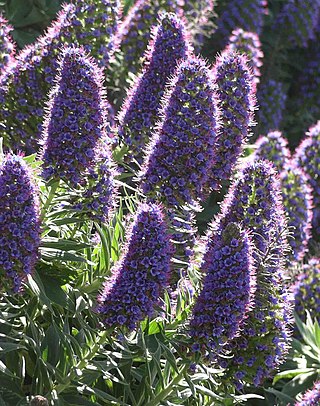
Echium candicans, the 'Pride of Madeira', is a species of flowering plant in the family Boraginaceae, and genus Echium, native to the island of Madeira. It is a large herbaceous perennial subshrub, growing to 1.5–2.5 m.
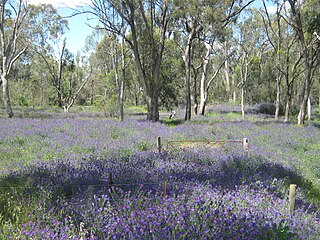
Paterson's curse or Salvation Jane is an invasive plant species in Australia. There are a number of theories regarding where the name Salvation Jane originated, and it is mostly used in South Australia. These explanations include "salvation jane" referring to the flower which looks similar to the bonnets of Salvation Army ladies, its “salvation” to beekeepers because it is often in flower when the honeyflow is down, and due to its use as a source of emergency food for grazing animals when the less drought-tolerant grazing pastures die off. Other names are blueweed, Lady Campbell weed, Riverina bluebell, and purple viper's bugloss.

Echium pininana, commonly known as the tree echium, pine echium, giant viper's-bugloss, or tower of jewels, is a species of flowering plant in the borage family Boraginaceae. It is endemic to the Canary Islands, where it is restricted to the island of La Palma. Echium pininana is an endangered species, and is listed in Appendix I to, and is therefore protected under, the Convention on the Conservation of European Wildlife and Natural Habitats. The specific epithet pininana is Latin for "small pine", though E. pininana is neither closely related to the pine, nor does it resemble that plant.

Artemisia biennis is a species of sagebrush known by the common name biennial wormwood. It is a common and widely distributed weed, so well established in many places that its region of origin is difficult to ascertain. This species is most likely native to northwestern North America and naturalized in Western Europe, and eastern and southern North America.

Echium wildpretii subsp. trichosiphon is a species of Echium that is found high up in the area of La Caldera de Taburiente on the Canary Island of La Palma. Like its sister plant on Tenerife, this plant forms a large rosette of silvery leaves which eventually give rise to tall spikes of bright pink flowers. The plant is biennial and dies after flowering. This plant can be grown in gardens, but requires good drainage and fairly mild conditions. The plant hates water falling in the centre of the rosette and will often rot in such conditions.
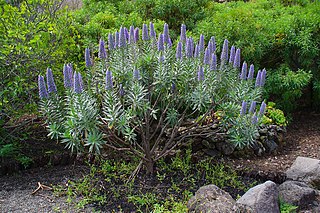
Echium webbii is a species of flowering plants of the family Boraginaceae. It is endemic to the Canary Islands, where it is restricted to the island of La Palma. The species was first described by Auguste-Henri de Coincy. The specific name webbii refers to botanist Philip Barker Webb.
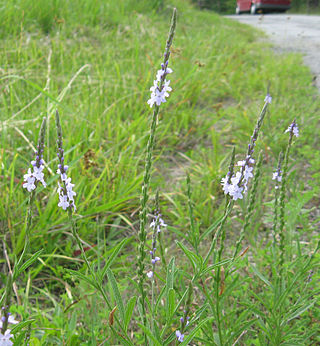
Verbena simplex, commonly known as narrowleaf vervain, is a perennial herbaceous plant plant in the Verbenaceae (vervain) family. It is native to central and eastern North America where it is found in open, dry, habitats on calcareous soil. It produces lavender flowers in the summer.

Echium hypertropicum is a species of flowering plants of the family Boraginaceae. The species is endemic to Cape Verde. It is listed as an endangered plant by the IUCN.

Echium aculeatum is a species of flowering plant of the family Boraginaceae. It is endemic to the Canary Islands, where it occurs on the islands El Hierro, La Palma, La Gomera and Tenerife. Its name in Spanish is ajinajo.
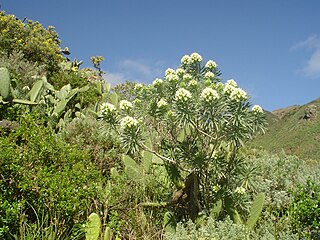
Echium leucophaeum is a species of flowering plants of the family Boraginaceae. It is endemic to the Canary Islands, where it is restricted to the island of Tenerife. Its name in Spanish is taginaste de Anaga. The specific name leucophaeum is from Greek and means "greyish white".

Echium judaeum, commonly known as the Judean viper's bugloss, is an annual plant endemic to southern Lebanon, southern Syria and Israel, of the Boraginaceae family, and which, like other herbaceous flowering plants of the same genus, derives its name from the style's resemblance to the forked-tongue of a serpent during the flower's pistillate-stage of development.


















